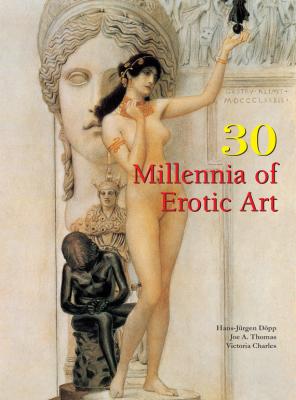30 Millennia of Erotic Art. Victoria Charles
Читать онлайн.| Название | 30 Millennia of Erotic Art |
|---|---|
| Автор произведения | Victoria Charles |
| Жанр | Изобразительное искусство, фотография |
| Серия | 30 Millennia |
| Издательство | Изобразительное искусство, фотография |
| Год выпуска | 2017 |
| isbn | 978-1-78310-333-1 |
106. Anonymous, Torso of Apsara, 11th century.
Indian art. Kiradu, Rajasthan. Stone. Sardar Museum, Jodhpur (India).
107. Anonymous, Linga within a Ring, 11th century.
Indian art. Silver, height: 27.5 cm. Private collection.
108. Anonymous, Vrikshadhirudhakam, mid-12th century.
Indian art. Stone. Surya Temple, Konarak (India). Private collection.
109. Anonymous, Devil and Hedonism, 1120–1135 CE.
Romanesque. West wall, south gate porch, abbey-church of St-Pierre, Moissac. In situ.
110. Anonymous, Adulterous Woman, second decade of the 12th century.
Romanesque. Puerta de las Platerías, Santiago de Compostela Cathedral, Santiago de Compostela. In situ.
111. Gislebertus, Temptation of Eve (Lintel from the North Portal of the Saint-Lazare Cathedral, Autun), c. 113 °CE.
Romanesque. Limestone, 72 × 131 cm. Musée Rolin, Autun.
112. Anonymous, Creation of Eve, 1130–1143 CE.
Romanesque. Mosaic. Palatine Chapel, Palermo.
113. Anonymous, Adam and Eve and Sodomites, 13th-14th century.
Gothic. Illustration from a French manuscript, the Bible moralisée. Österreichische Nationalbibliothek, Vienna.
114. Giotto (Giotto di Bondone), Hell (detail from Last Judgment), 1304–1306.
Proto Renaissance. Fresco, 1000 × 840 cm. Capella degli Scrovegni, Padua.
His full name was Ambrogiotto di Bondone, but he is known today, as he was in his own time, by the contraction Giotto, a word which has come to stand for almost all the great things that art has accomplished. In his own day Giotto’s fame as a painter was supreme; he had numerous followers, and these Giotteschi, as they were styled, perpetuated his methods for nearly a hundred years. In 1334, he designed the beautiful Campanile (bell tower), which stands beside the cathedral in Florence, and represents a perfect union of strength and elegance, and was partly erected in his lifetime. Moreover, the sculptured reliefs which decorate its lower part were all from his designs, though he lived to execute only two of them. Inspired by French Gothic sculpture, he abandoned the stiff presentations of the subjects as in Byzantine styles and advanced art towards more realistic presentation of contemporary figures and scenes so as to be more narrative. His breakthrough influenced subsequent development in Italian art. His significant departure from past presentations of the Maestà, starting around 1308 (in Madonna di Ognissanti), brought to it his knowledge of architecture and its perspectives. However, the disproportion of subjects in the presentation is a device intended to rank the subjects by their importance, as was done in Byzantine icons.
Thus, architect, sculptor, painter, friend of Dante and of other great men of his day, Giotto was the worthy forerunner of that galaxy of brilliant men who populated the later days of the Italian Renaissance.
115. Anonymous, Tacuinum Sanitatis, middle of the 15th century.
Gothic. Miniature, 35.5 × 22.5 cm. Bibliothèque nationale de France, Paris.
116. Guyart des Moulins, The Historical Bible, volume one, illustration to the Book of Daniel (Susanna and the Elders in the Garden), third quarter of 14th century.
Gothic. Parchment, 45.5 × 31.5 cm. Private collection.
117. Memmo di Filippuccio, The Bedroom, c. 1318.
Proto Renaissance. Museo Civico, San Gimignano.
118. Bartholomeus Anglicus, Book of the Properties of Things (De proprietatibus rerum), c. 1400.
Gothic. Herzog-August-Bibliothek, Wolfenbüttel.
119. Anonymous, Illuminated Manuscript.
Gothic. Private collection.
120. Anonymous, Young Nun Gathering Penises.
Illuminated Manuscript. Gothic. Private collection.
121. Anonymous, Illuminated Manuscript.
Gothic. Private collection.
122. Anonymous, God Mercury Explains that Marriage Must Be Based on Love, frontispiece of Plutarch’s Treatise on Marriage Questions, Addressed to Eurydice and Pollianus, 15th-16thcentury.
Early Renaissance. Parchment, 45.5 × 31.5 cm. Bibliothèque nationale de France, Paris.
123. Anonymous, Illuminated Manuscript.
Gothic. Private collection.
124. Master of Manta Castle, The Fountain of Youth: Cycle of the nine heroes and nine heroines, after 1416.
Late Gothic. Fresco. Castello della Manta, Saluzzo.
125. Anonymous, The King Wenceslas and the Bathers (miniature from the Bulle d’Or of the Emperor Charles IV), 1400.
Gothic. Österreichische Nationalbibliothek, Vienna.
126. Filippo Calendario, Original Sin, 1340–1355.
Gothic. Marble. Palazzo ducale di Venezia, Venice.
127. Anonymous, Adam (from the south-side of the Notre-Dame Transept, Paris), c. 1260.
Gothic. Polychrome stone, height: 200 cm. Musée national du Moyen Age, Thermes de Cluny, Paris.
This statue of Adam is one of the rare nudes of medieval art. Larger than life-size, this statue originally decorated the exterior of Notre-Dame in Paris. Paired with Eve, it was part of a Last Judgment scene. The nudity of the figure recalls classical prototypes, and the s-shaped pose and sinuous body of Adam owes a particular debt to 4th-century BCE sculptors such as Praxiteles and Lysippos. The soft, unmuscled body, however, does not reflect the classical ideal. Most of the human sculpture of the Middle Ages was clothed in long robes, and a sculptor would have had little opportunity to study the nude. Despite the lack of precedent, however, the sculptor of this piece has captured the human body in detail, showing the anatomy below the surface, especially on the figure’s torso.
128. Arnolfo di Cambio, Sick Man at the Fountain (sculpture fragment), c. 13th century.
Gothic.
